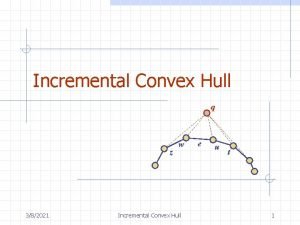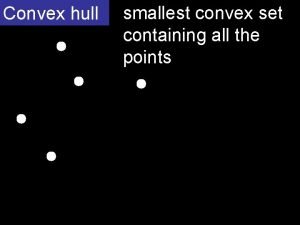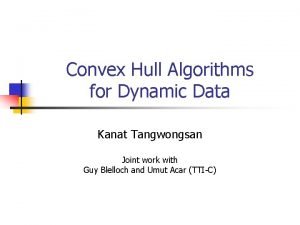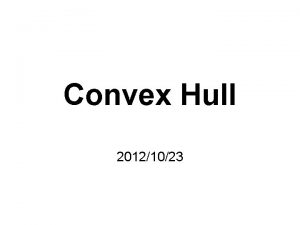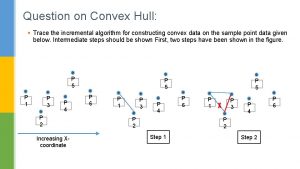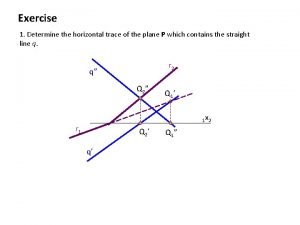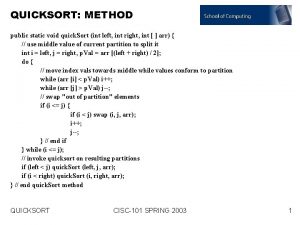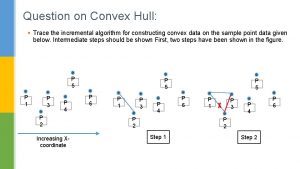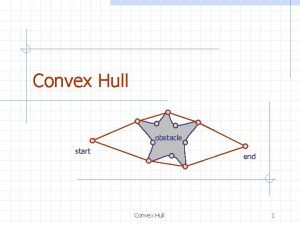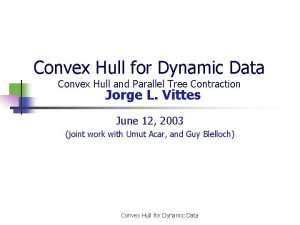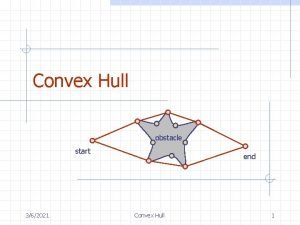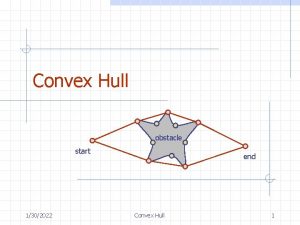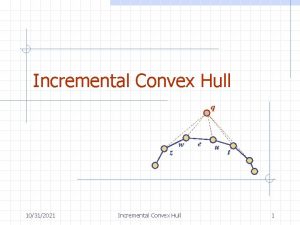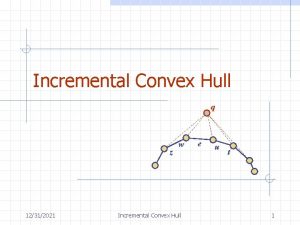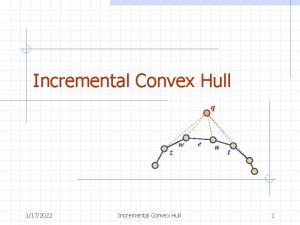Question on Convex Hull Trace the incremental algorithm










- Slides: 10

Question on Convex Hull: § Trace the incremental algorithm for constructing convex data on the sample point data given below. Intermediate steps should be shown First, two steps have been shown in the figure. P 5 P 1 P 3 P 4 P 2 Increasing Xcoordinate P 5 P 6 P 1 P 3 P 4 P 2 Step 1 Step 2 P 6

P 5 P 1 P 3 P 6 P 4 P 1 P 3 P 4 P 1 Step 4 P 2 Step 6 P 1 P 6 P 4 Step 5 P 5 P 4 P 3 P 2 Step 3 P 6 P 2 P 1 P 5 P 3 P 4 P 2 P 5 P 6 P 1 P 3 P 4 P 2 Step 7 Step 8 P 6

Question on Green Yao Algorithm: § Show the final result after applying Green-Yao’s algorithm on the following input image to snap each intersection point to its nearest grid point. Your final figure should show all the break points (to prevent too much drifting) inserted by the green-yao algorithm.

Question on Douglas-Pucker Algorithm Which of the following properties are true for the Douglas-Pucker Algorithm (DPA) for discretizing simple arcs? Briefly justify your answer. Assume that a finite error threshold is provided for distance between linestring and farthest point on arc. § Correctness: Linestring produced by DPA will meet the specified error threshold. In addition, DPA terminates of all given arc. § Solution quality: The line-string produced by DPA is optimal in number of vertices. In other words, any line-string (discretizing given arc withing the error threshold) will have at least as many points as the line-string produced by DPA. § Response time: If input arc is a linestring with N point, worst-case computational complexity of DPA is no worse than O(N*N). § Solution property: If input arc is symmetric along the perpendicular bi-sector of the line joining arc's end-points, the number of points in the linestring produced by DPA will be a integral power of 2.

Question on Spatial Queries Classify following GIS operation by relational algebra operations of select, project, and join: § Slope and aspect, e. g. determine high slope area given elevation data. § Flag soil erosion risk for locations close to rivers, with high slopes, poor vegetation and soil. § Topological modeling, e. g. list countries adjacent Russia. § Map overlay of soil-type polygons, and high-slope polygons, to identify erosion risks. § Networks (e. g. If a pollutant is spilled in a river, how long would it take the pollutant to reach a drinking water plant downstream? )

Question on General Spatial Concepts Q 1. Which of the following statements are false ? (a) Inside, outside and boundary are basic topological operations. (b) 9 -intersection model formalizes binary topological relationship. (c) Topological relationships change under elastic deformation. (d) Direction (e. g. , North, left) is a topological relationship. Q 2. Which of the following is not a topological query ? (a) Which country has highest number of neighboring countries? (b) List airports within 100 miles of Chicago, Illinois. (c) Which rivers flow via at least six countries? (d) List four US states whose boundaries are not defined by any rivers. (e) List US cities which are north-west of a Canadian city.

Question on General Spatial Concepts Q 3. Which of the following pairs are disjoint ? (a) interior( Vatican City), interior (Italy) (b) boundary( Vatican City), interior (Italy) (c) interior( Vatican City), boundary (Italy) (d) boundary( Vatican City), boundary (Italy) Q 4. Which of the following is modeled naturally by Entity Relationship Diagrams? (a) Field (also knows as Raster) geographic data (b) Object (also known as Vector) geographic data (c) Map Algebra (d) All of the above.

Question on General Spatial Concepts Classify following operations into local, focal and zonal operations on an elevation field defined over a grid (square based regular planar tessellation): § ASPECT: identifies the direction of maximum rate of change in z value from each cell. § BOUNDARYCLEAN: smoothes the boundary between zones by expanding and shrinking the boundary. § HILLSHADE: creates a shaded relief grid from a grid by considering the sun illumination angle and shadows. § INT: converts input floating-point values to integer values through truncation. § ISNULL: returns “ 1” if the input value is NODATA, and “ 0” if it is not. § MEAN: uses multiple input grids to determine the mean value on a cell-by-cell basis. § SLOPE: identifies the rate of maximum change in z value from each cell. § ZONALAREA: calculates the area of each zone in the input grid.

Question on Spatial Query Languages Suppose we have a CITY table and RIVER table containing a list of cities and rivers, respectively. The shapes of cities are points, while the shapes of rivers are line strings representing their centerlines. Which of the following queries returns different result than others? 1) SELECT C. Name FROM City C, River R WHERE Distance (C. Shape, R. Shape) <= 300 2) SELECT C. Name FROM City C, River R WHERE Within (C. Shape, Buffer (R. Shape, 300)) 3) SELECT C. Name FROM City C, River R WHERE Contains (C. Shape, Buffer (R. Shape, 300)) 4) SELECT C. Name FROM City C, River R WHERE Cross (R. Shape, Buffer (C. Shape, 300))

Question on Spatial Query Languages Provide the English statement of the following SQL query: SELECT Co 1. Name FROM COUNTRY_SPATIAL Co. S 1, COUNTRY_SPATIAL Co. S 2 WHERE Touch (Co. S 1. Shape, Co. S 2. Shape) = 1 AND Co. S 2. Name = ‘Canada
